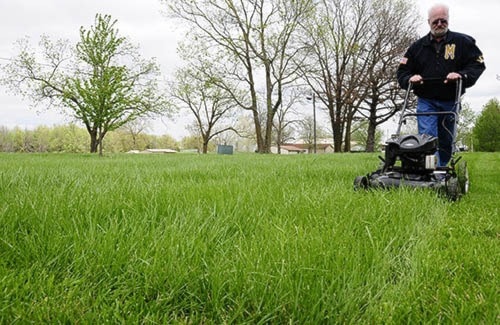By Kevin Gillies
Is it too early to talk about getting the lawn ready for summer?
With the Lower Mainland’s wacky winter carrying right on through February, Facebook is already showing evidence of folks’ lawn-mowing efforts.
Excuse the poor English and pun, but this jest ain’t right?
The thermometre has been hovering around the 15 C, trees are blossoming, plants are blooming, and yet there’s still Christmas lights dangling from gutters.
It’s time to, ahem, spring into action, starting with those icicle lights.
Then it will be all about buying seed, fertilizer, herbicide, lawnmower service, string trimmers, and, perhaps, other equipment in an effort to create the ideal lawn – a lush, green expanse of grass that looks and feels level, balanced, and beautiful, and feels cool between the toes.
Apparently it’s time to prepare our lawns for spring – in February (eat your heart out East Coast).
It’s time to set the blade high for that first cut, then pull the rip chord on your mower.
To start, rake the lawn to remove dead growth and leftover debris from the winter.
Raking helps bring light and air to the soil, and encourage grass to grow.
Where needed, rake bare patches of lawn firmly with a metal rake, then reseed the area.
Try sprinkling some grass seed into a bucket of soil, then spreading it evenly over the bare spot.
Remember to keep the area well-watered until seeds new grass is established.
And pre-emergent herbicides like corn gluten could be applied now.
And what about that sad sack looking winter-ravaged garden?
This would also be a good time to thin the dead foliage of ornamental grasses, ferns and other plants or bushes.
Once new growth begins, it can become difficult to thin ornamental plants out without damaging them.
New growth will quickly replace the culled foliage and debris.
And, in case you didn’t get around to this in the fall, pull the old tomato, squash and other plant skeletons to clear the bed for new planting.
Plant skeletons can be added to your compost as long as you’re sure they aren’t diseased.
When it’s dry enough, ‘top dressing’ the beds is a good idea.
Top dress your garden beds with compost or well-seasoned manure in preparation for planting.
Try to resist the urge to dig the bed up as established beds have complex soil ecosystems, which is usually best left undisturbed.
Nutrients added from the top will work their way down into the soil.
And, to compact the spring process, early spring is the best time for lime.
Soils with a pH level below 6.2 will benefit from the addition of lime. Soil pH can be determined, using a soil pH test kit.
Dolomite is the finest grind, and recommended.
With ground limestone it takes twice as long for plants to derive benefit and ideally, lime is added several weeks before actual planting.
Hydrate lime (quick lime) is not recommended as it can change the soil pH level so rapidly that plants can be damaged.
Cover newly limed beds with plastic during heavy spring rains to prevent material runoff.
Happy almost-spring, everyone.
